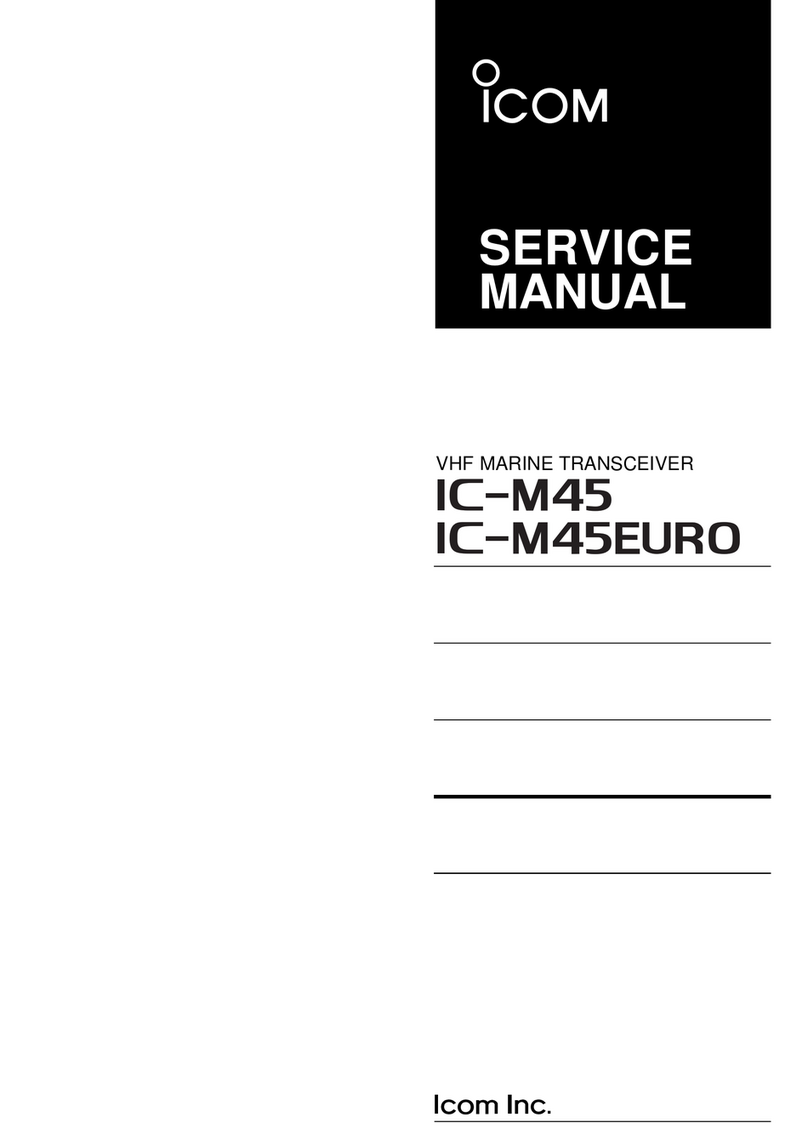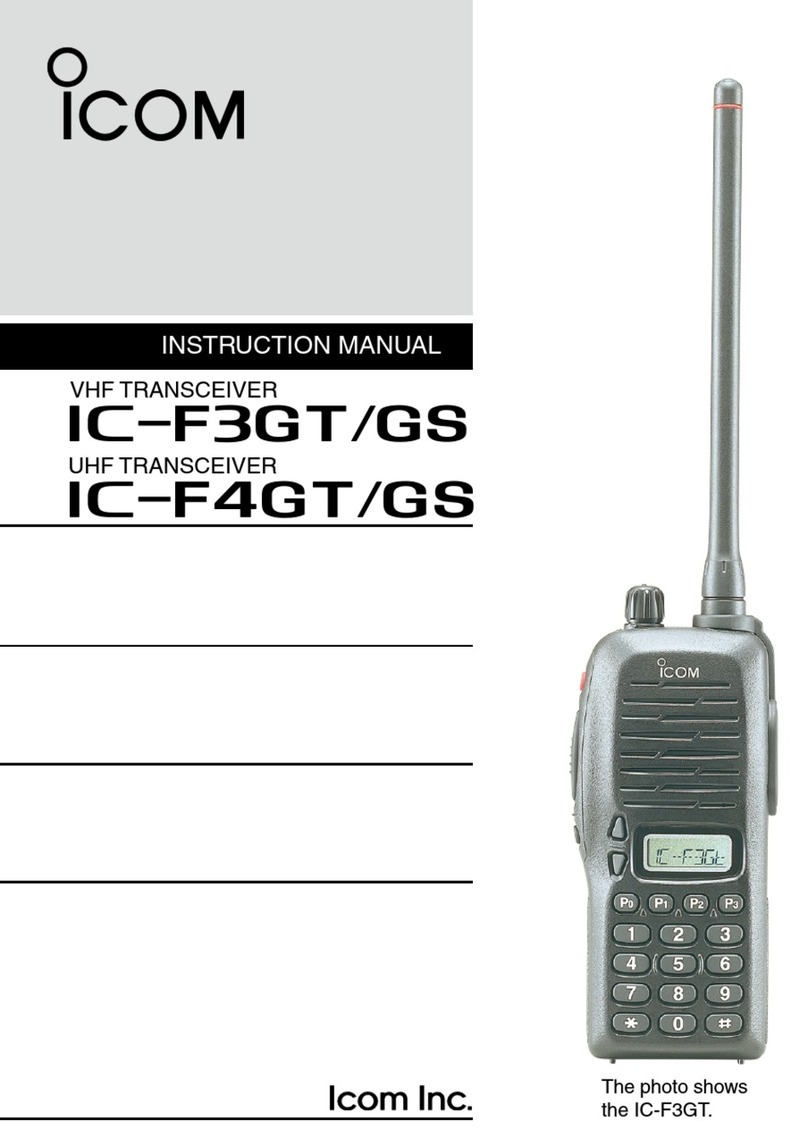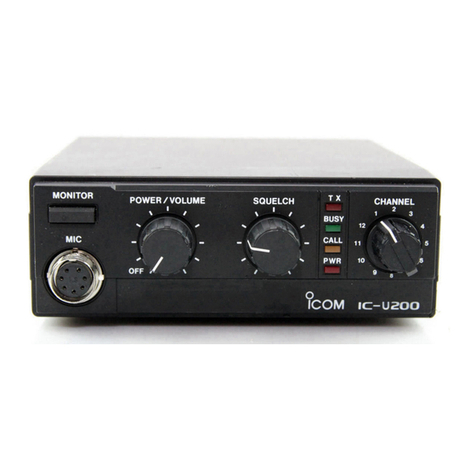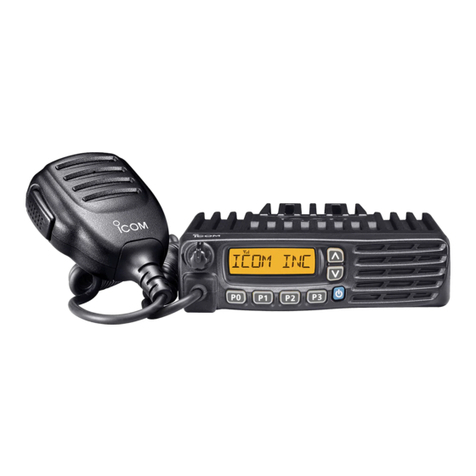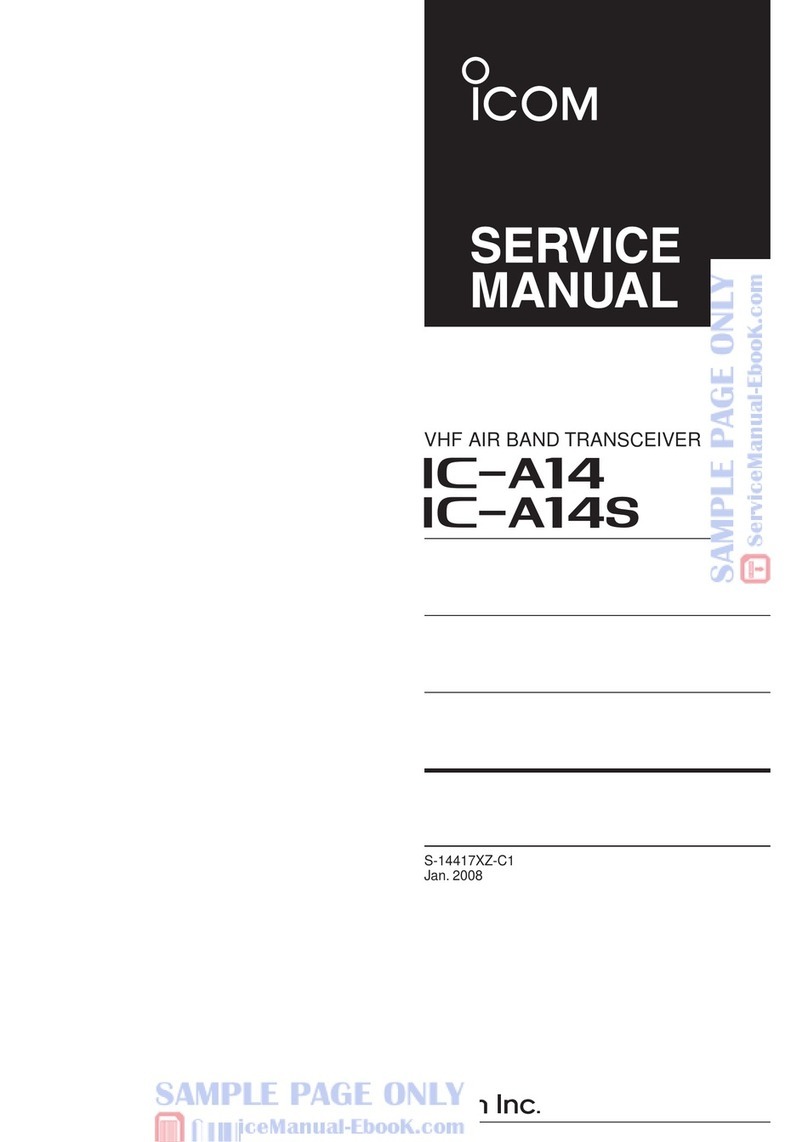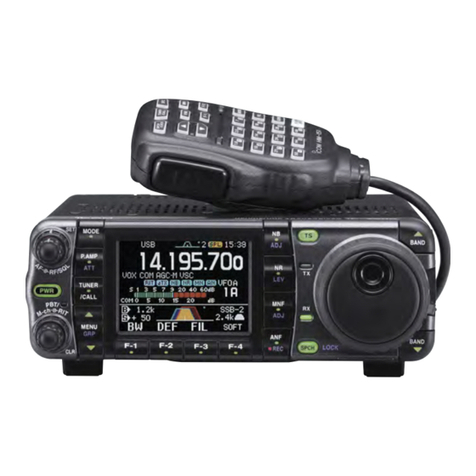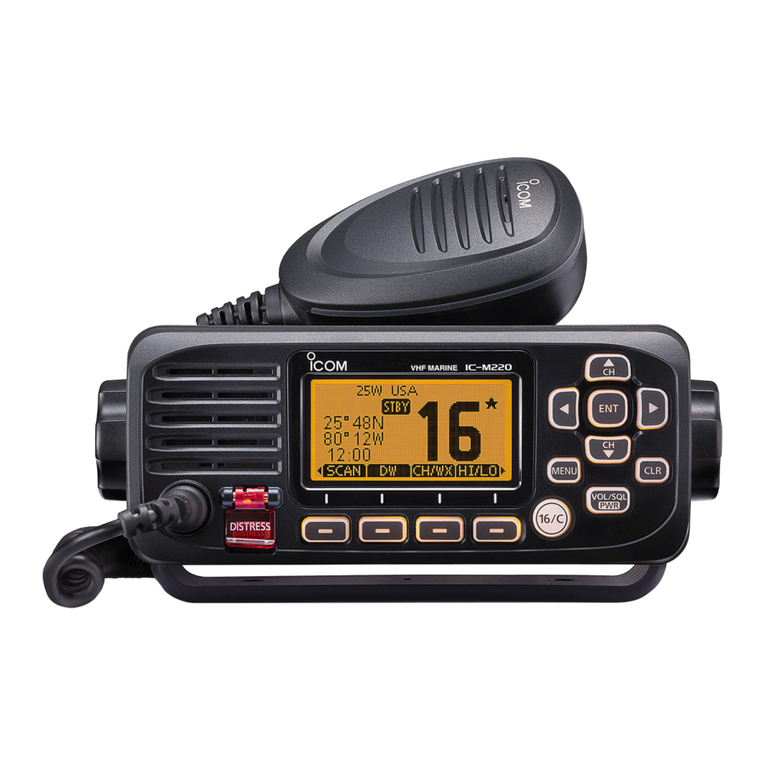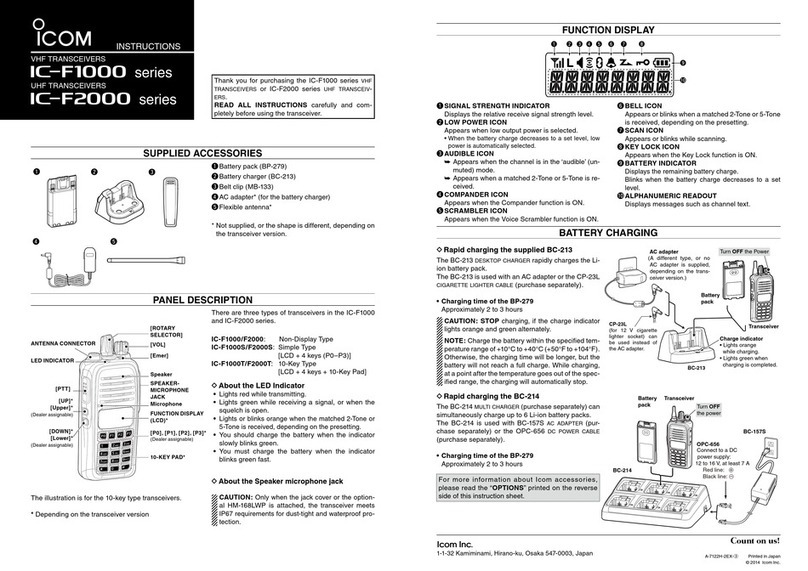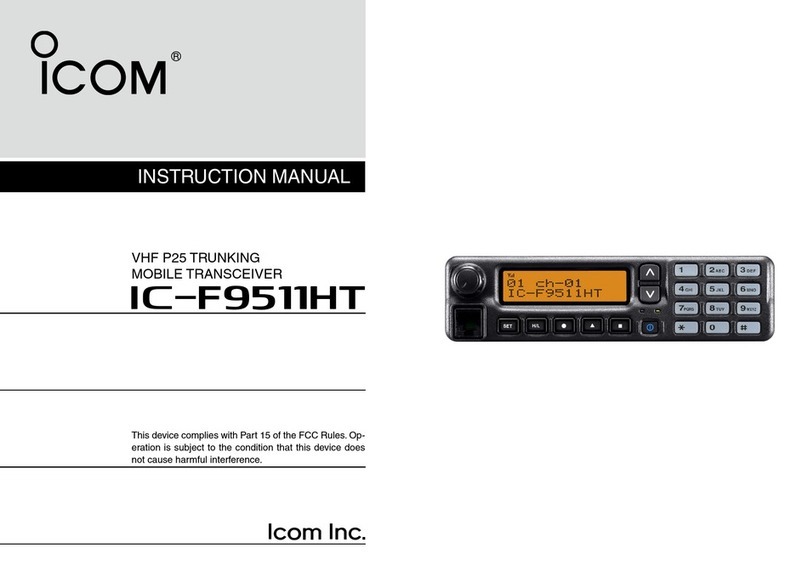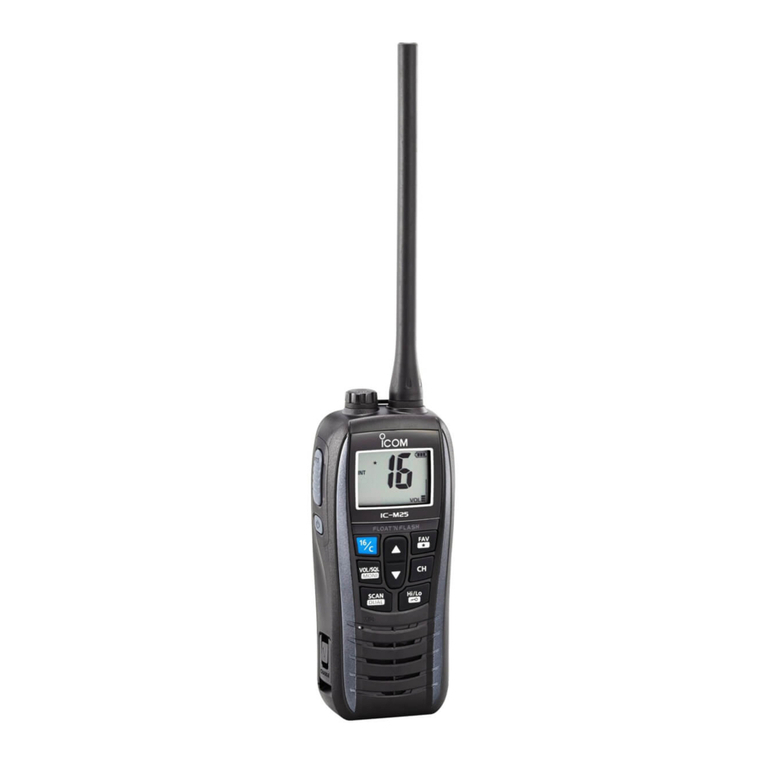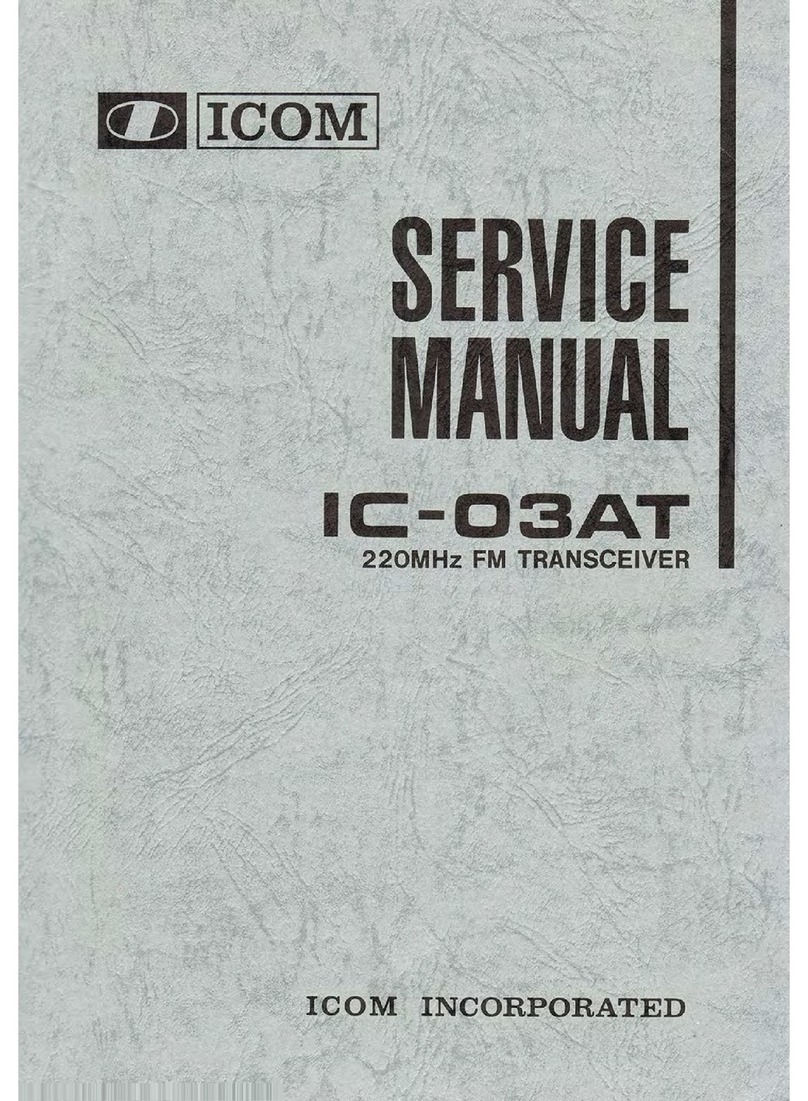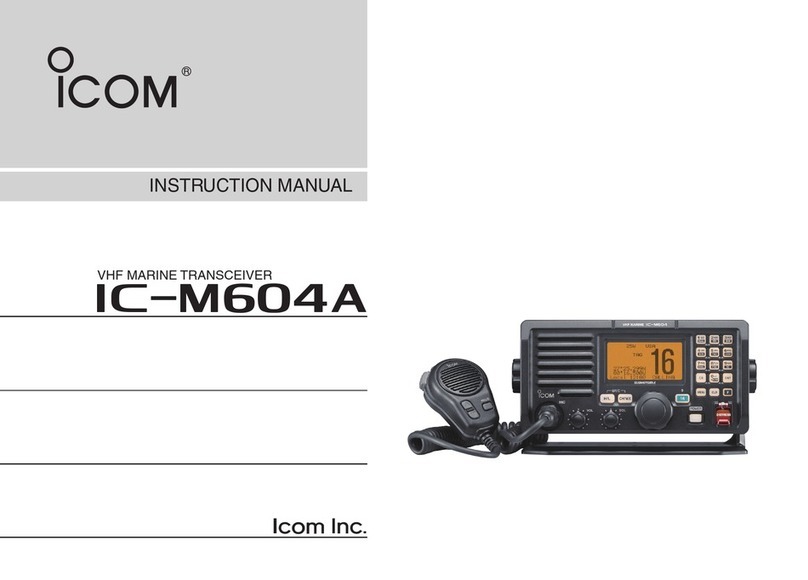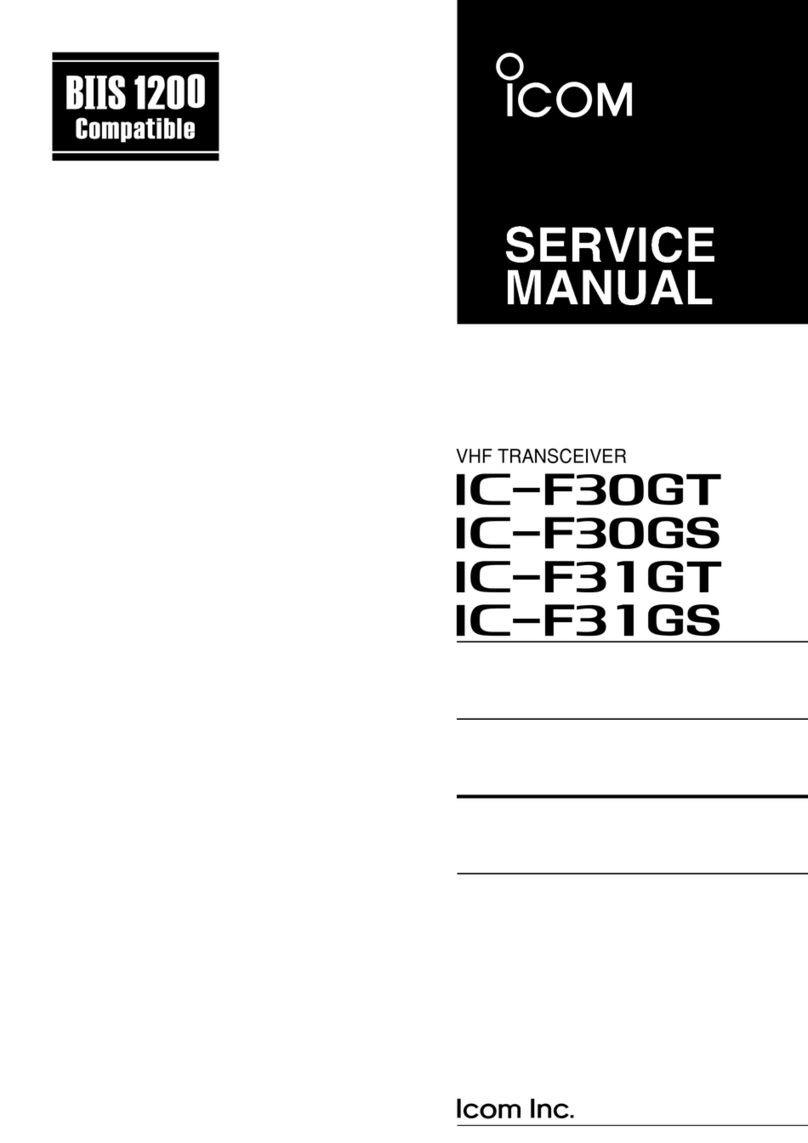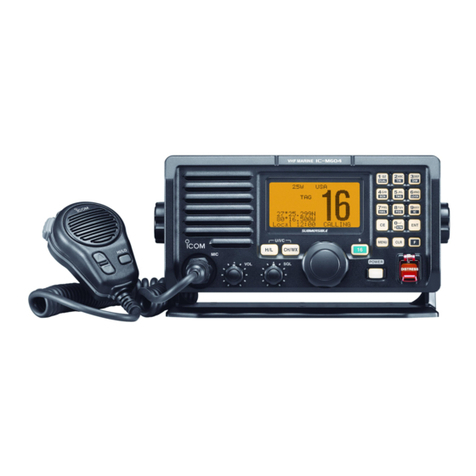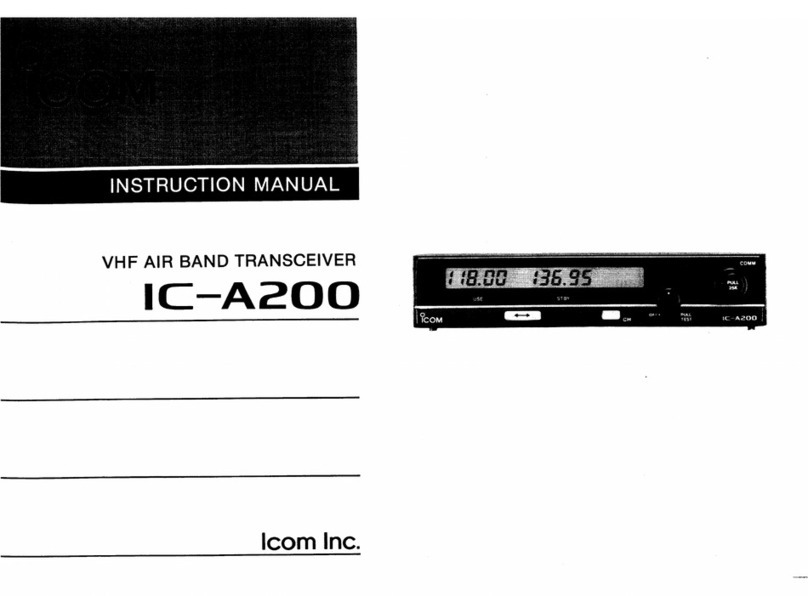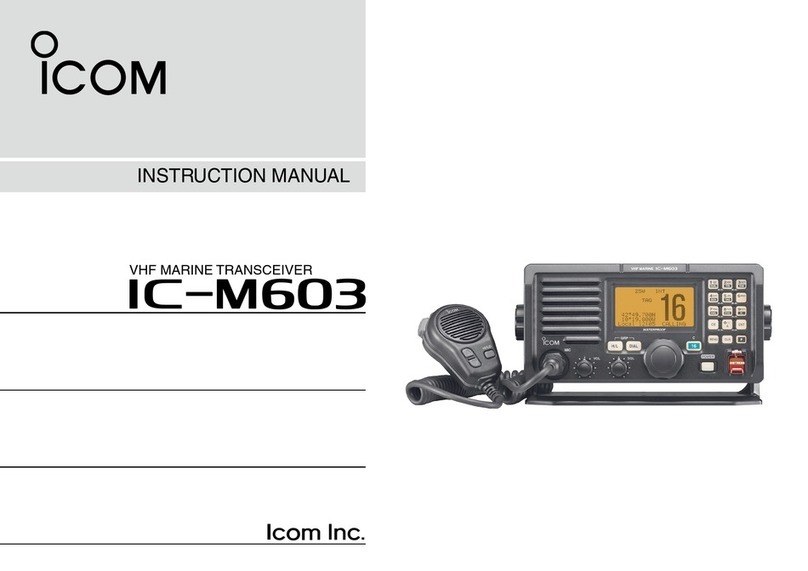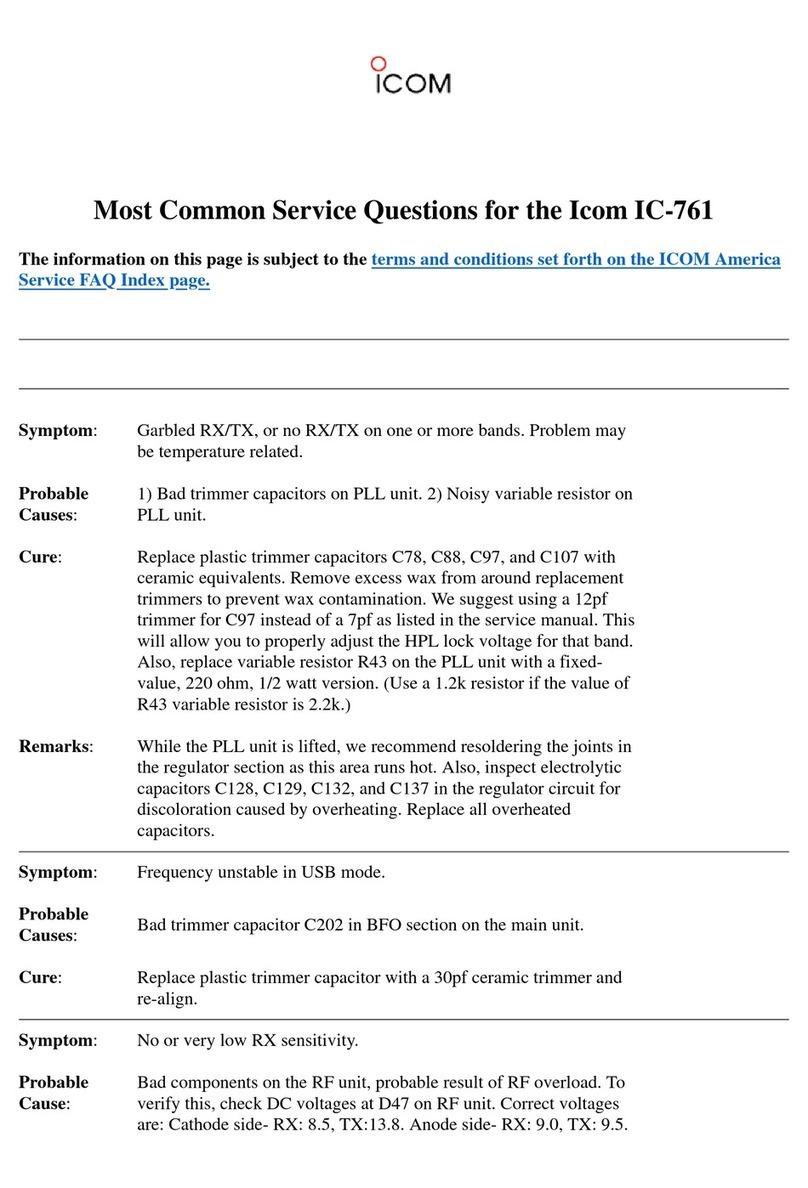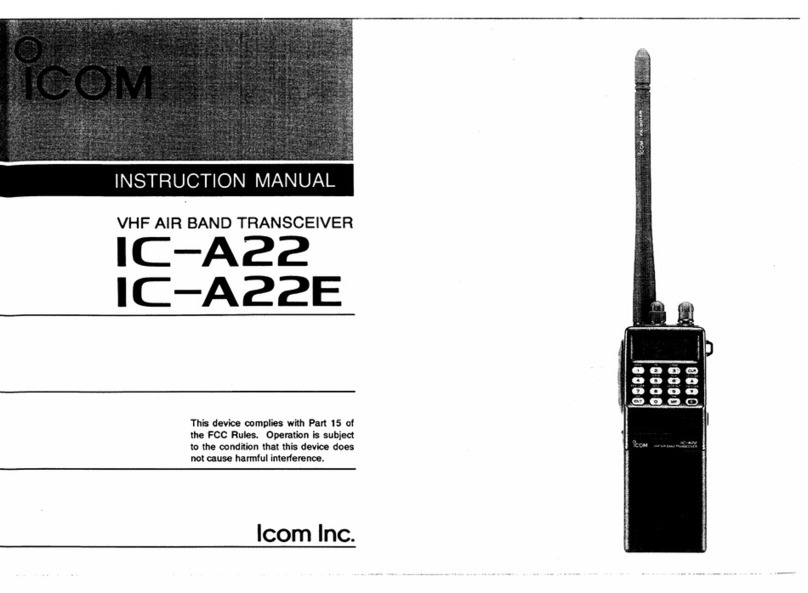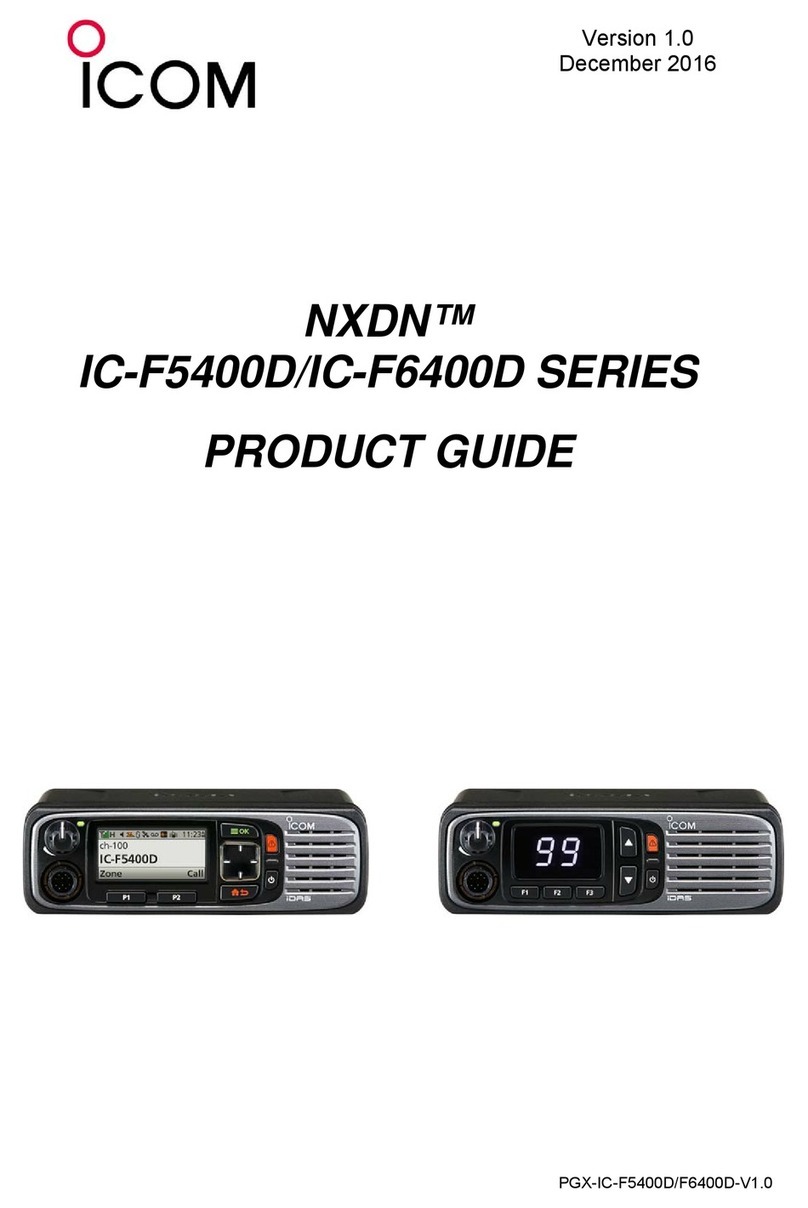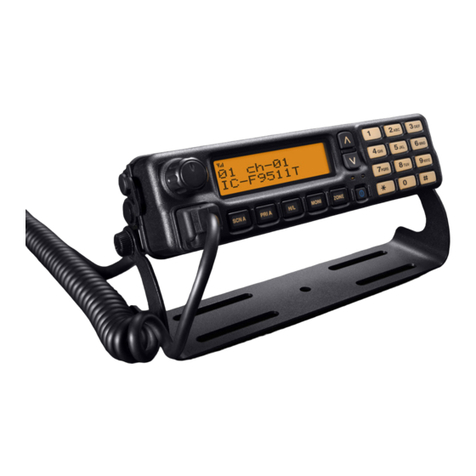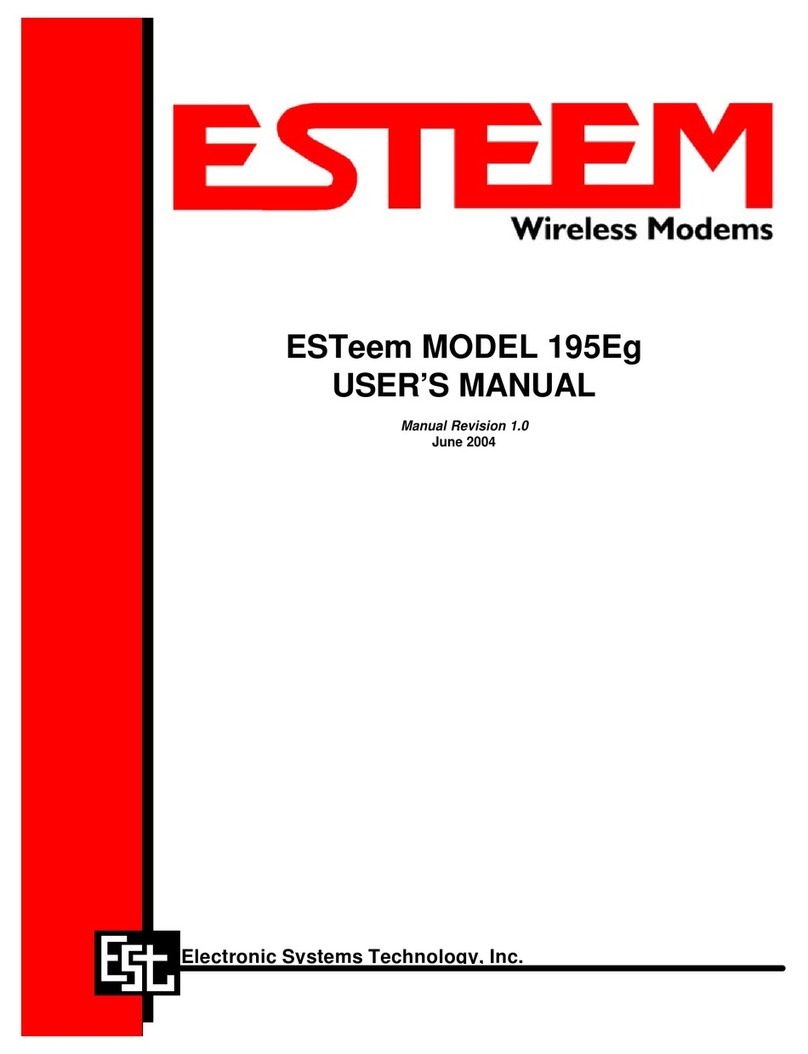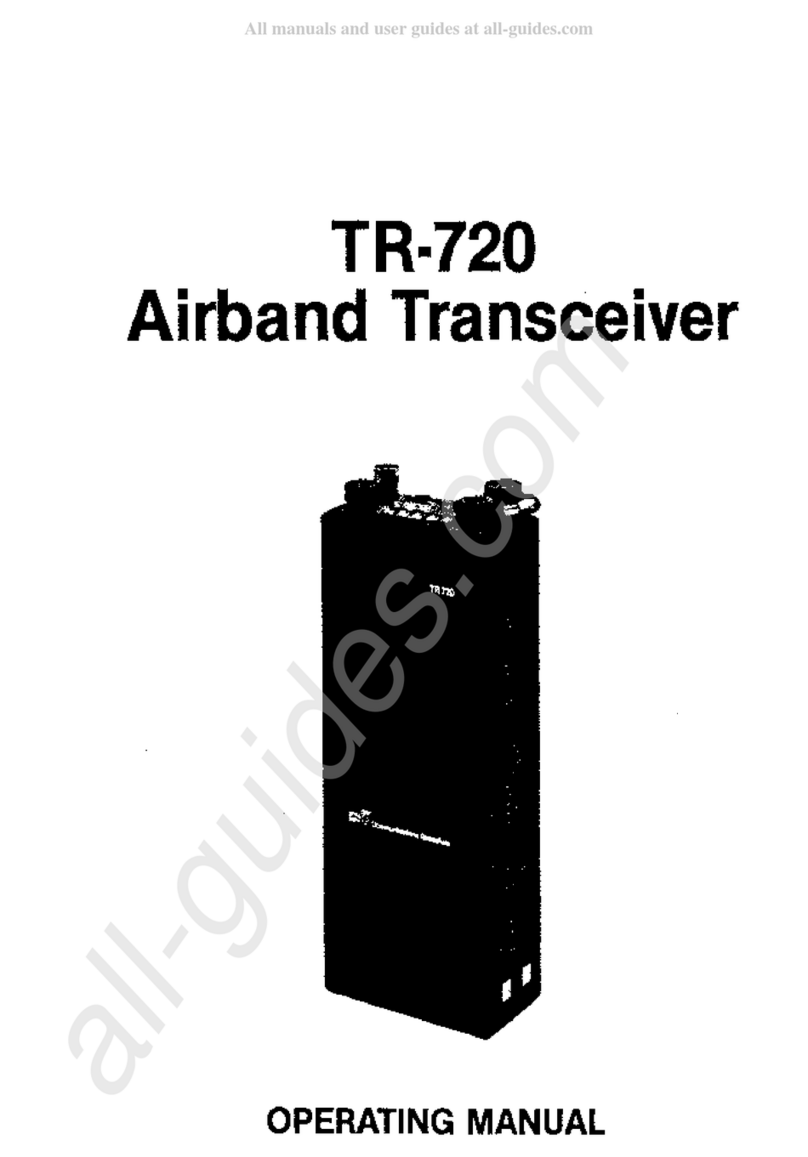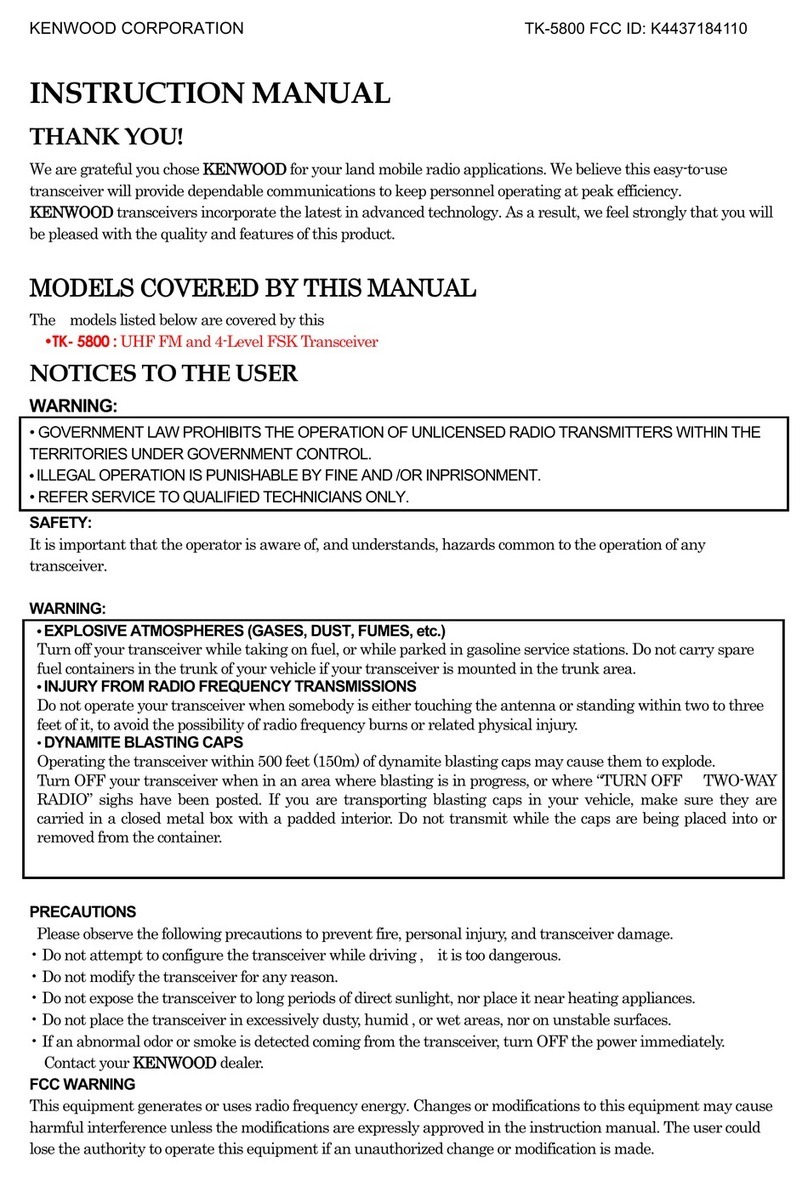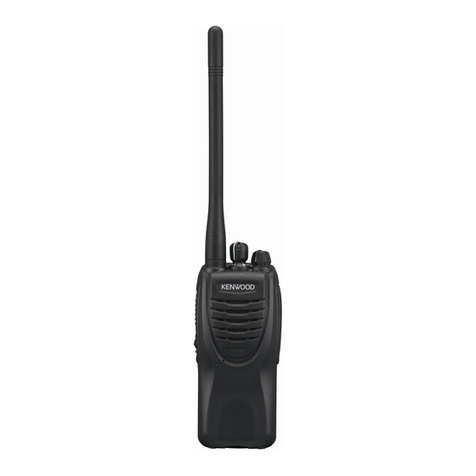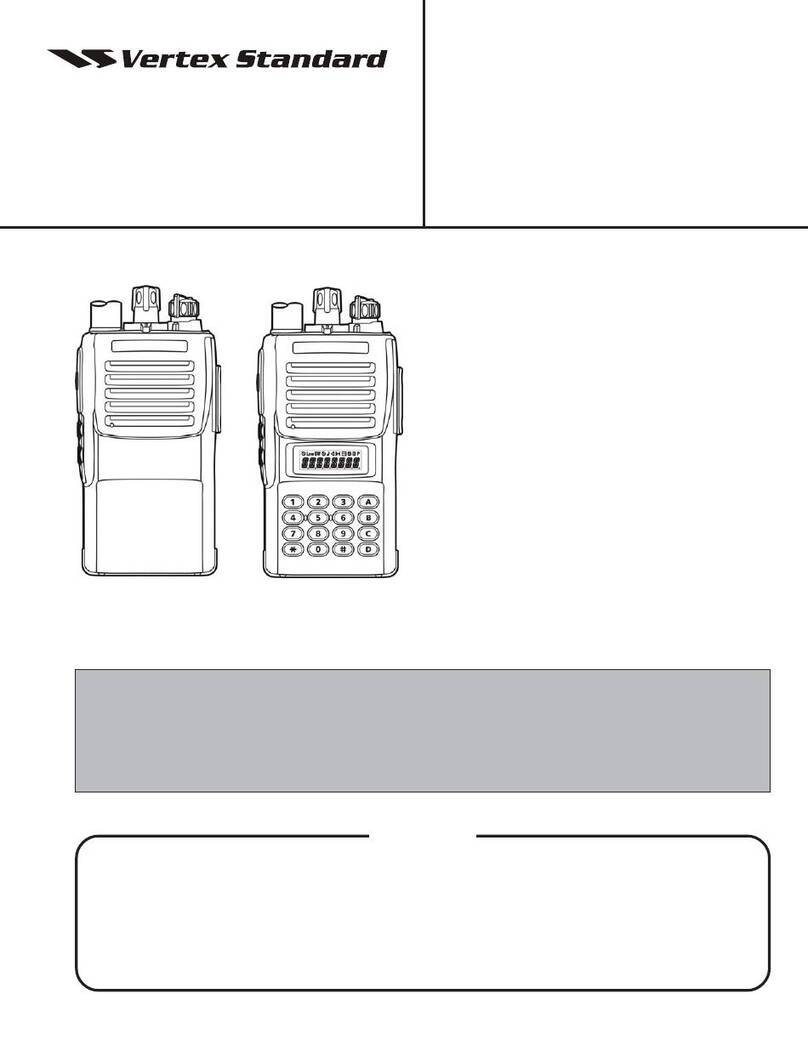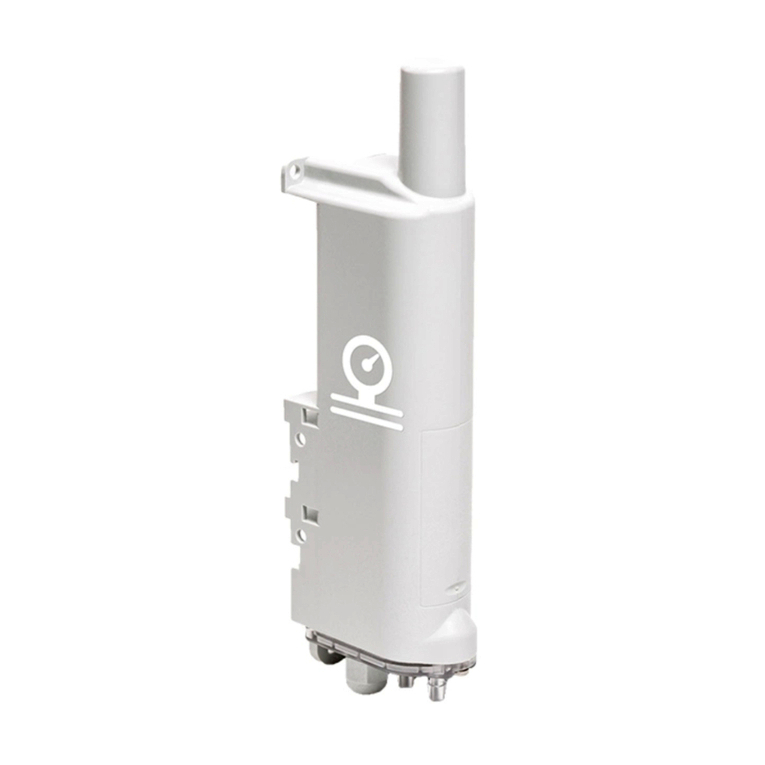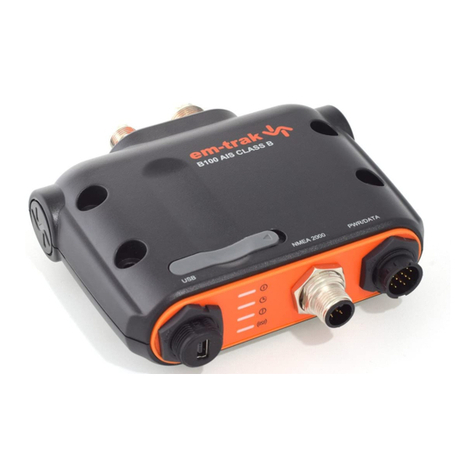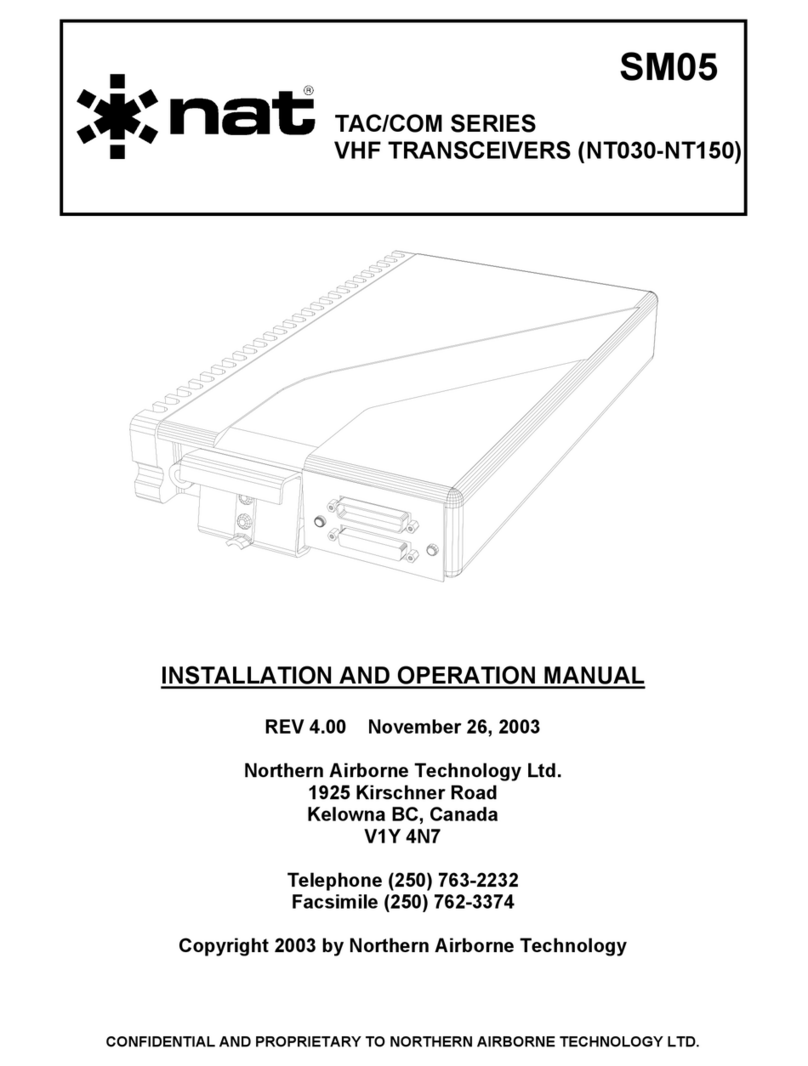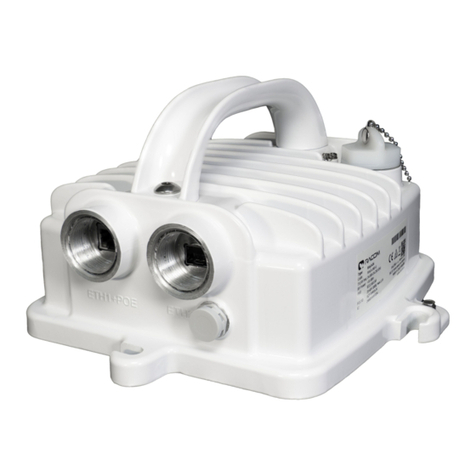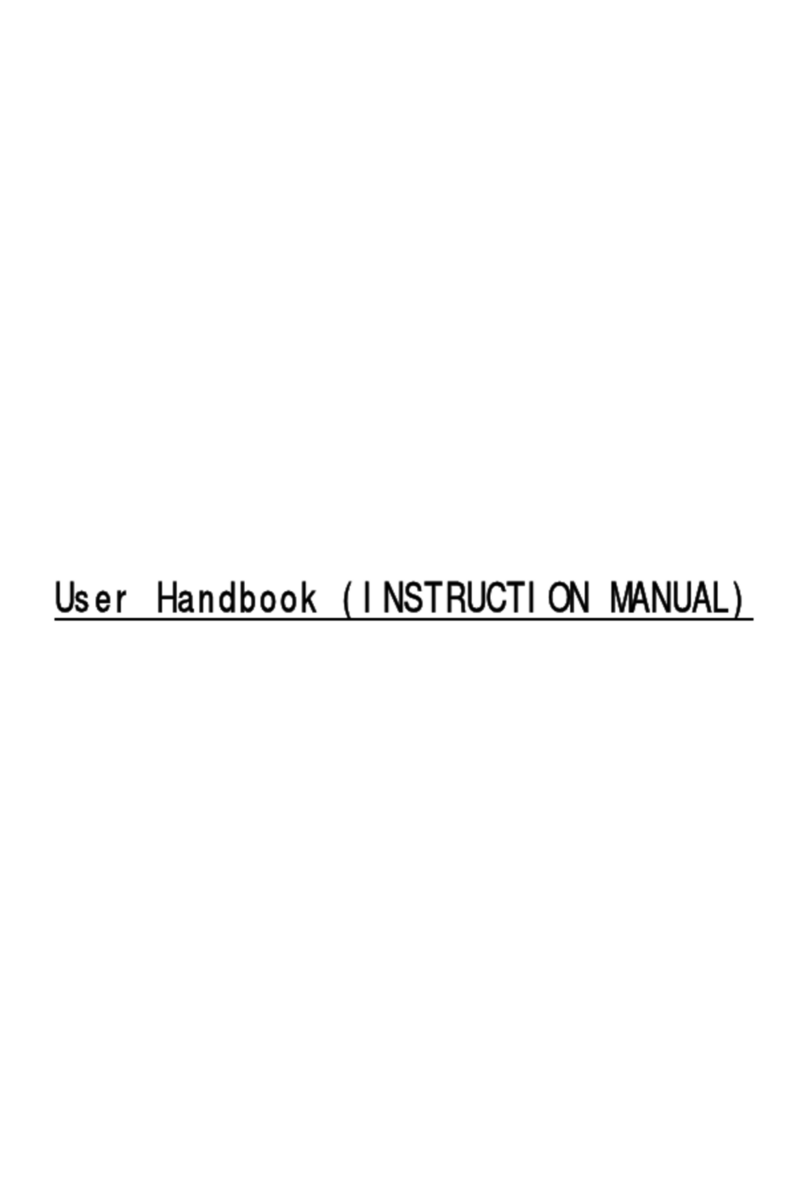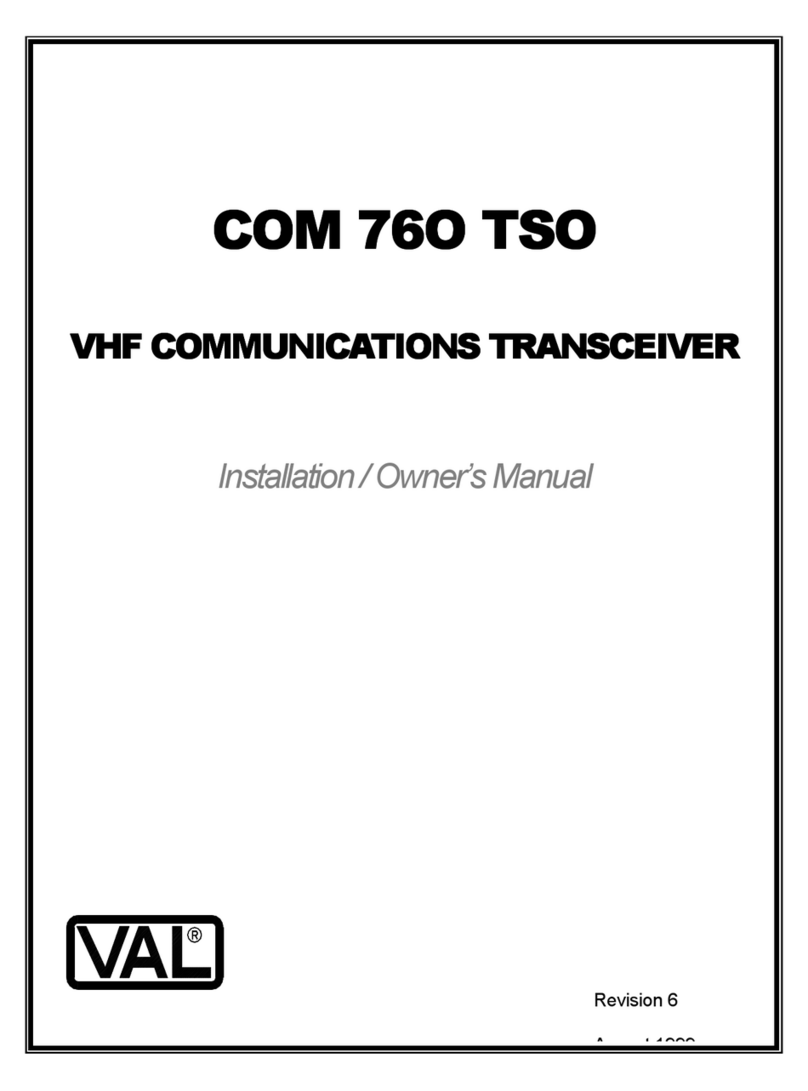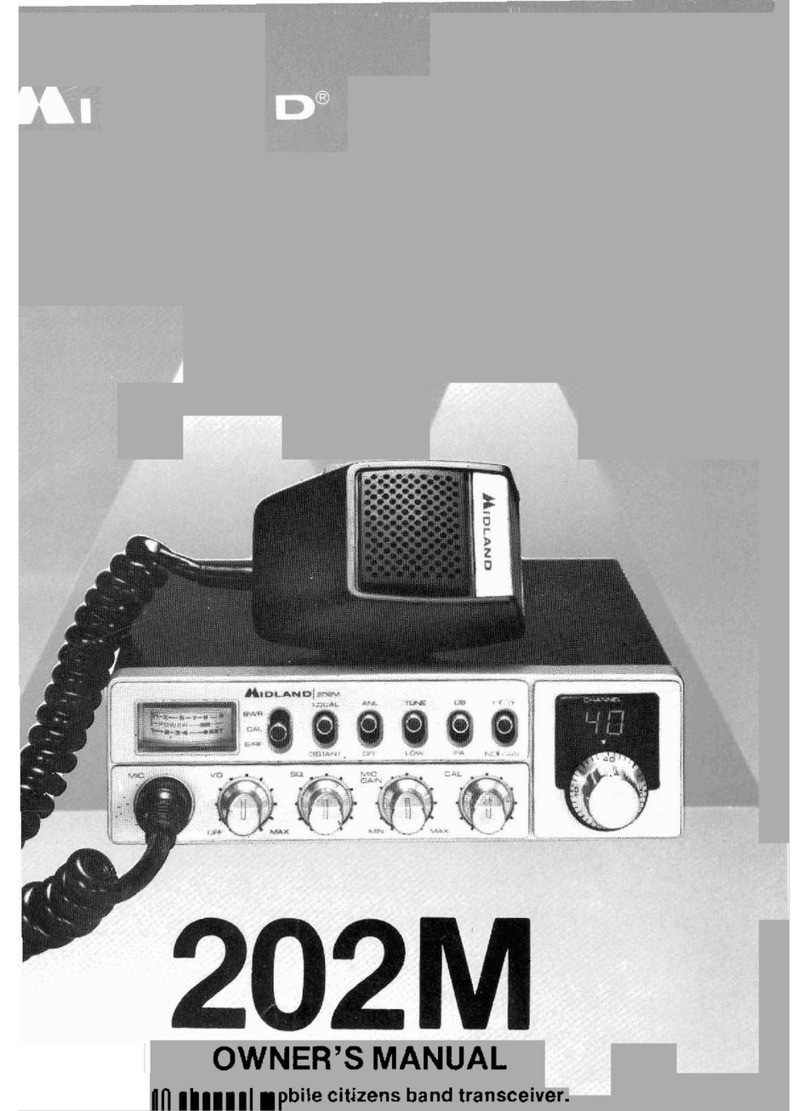Icom IC-F5121D User manual

S-14713XZ-C1
Feb. 2011
VHF MOBILE TRANSCEIVERS

This service manual describes the latest technical
information for the IC-F5121D, IC-F5122D and IC-F5123D
VHF TRANSCEIVERS, at the time of publication.
NEVER connect the transceiver to an AC outlet or to a DC
power supply that uses more than the specified voltage.
This will ruin the transceiver.
DO NOT expose the transceiver to rain, snow or any liquids.
DO NOT reverse the polarities of the power supply when
connecting the transceiver.
DO NOT apply an RF signal of more than 20 dBm (100 mW) to
the antenna connector. This could damage the transceiver’s
front-end.
To upgrade quality, any electrical or mechanical parts
and internal circuits are subject to change without notice
or obligation.
MODEL VERSION CHANNEL
SPACING (kHz)
TX
POWER
IC-F5121D [USA-01] 6.25/12.5/25.0 50 W
IC-F5122D [EUR-01] 6.25/12.5/20.0/25.0 25 W
IC-F5123D [EXP-01] 6.25/12.5/25.0
[EXP-02] 50 W
Be sure to include the following four points when ordering
replacement parts:
1. 10-digit Icom part number
2. Component name
3. Equipment model name and unit name
4. Quantity required
<ORDER EXAMPLE>
1110007320 S.IC NJM2591V IC-F5121D MAIN UNIT 5 pieces
8820001210 Screw 2438 screw IC-F5122D Top cover 10 pieces
Addresses are provided on the inside back cover for your
convenience.
ORDERING PARTS
1. Make sure that the problem is internal before
disassembling the transceiver.
2. DO NOT open the transceiver until the transceiver is
disconnected from its power source.
3. DO NOT force any of the variable components. Turn
them slowly and smoothly.
4. DO NOT short any circuits or electronic parts. An
insulated tuning tool MUST be used for all adjustments.
5. DO NOT keep power ON for a long time when the
transceiver is defective.
6. DO NOT transmit power into a Standard Signal
Generator or a Sweep Generator.
7. ALWAYS connect a 50 dB to 60 dB attenuator between
the transceiver and a Deviation Meter or Spectrum
Analyzer, when using such test equipment.
8. READ the instructions of the test equipment throughly
before connecting it to the transceiver.
REPAIR NOTES
INTRODUCTION CAUTION
(IC-F5121D)
Icom, Icom Inc. and the Icom logo are registered trademarks of Icom Incorporated (Japan) in Japan, the United States, the
United Kingdom, Germany, France, Spain, Russia and/or other countries.

TABLE OF CONTENTS
SECTION 1 SPECIFICATIONS
SECTION 2 INSIDE VIEWS
SECTION 3 DISASSEMBLY INSTRUCTION
SECTION 4 OPTIONAL CABLE INSTALLATION
SECTION 5 CIRCUIT DESCRIPITON
5-1 RECEIVER CIRCUITS. . . . . . . . . . . . . . . . . . . . . . . . . . . . . . . . . . . . . . . . . . . . . . . . . . . . . . . . 5-1
5-2 TRANSMITTER CIRCUITS . . . . . . . . . . . . . . . . . . . . . . . . . . . . . . . . . . . . . . . . . . . . . . . . . . . . 5-2
5-3 FREQUENCY SYNTHESIZER CIRCUITS . . . . . . . . . . . . . . . . . . . . . . . . . . . . . . . . . . . . . . . . 5-3
5-4 VOLTAGE DIAGRAM . . . . . . . . . . . . . . . . . . . . . . . . . . . . . . . . . . . . . . . . . . . . . . . . . . . . . . . . . 5-3
5-5 PORT ALLOCATIONS . . . . . . . . . . . . . . . . . . . . . . . . . . . . . . . . . . . . . . . . . . . . . . . . . . . . . . . . 5-4
SECTION 6 ADJUSTMENT PROCEDURE
6-1 PREPARATION . . . . . . . . . . . . . . . . . . . . . . . . . . . . . . . . . . . . . . . . . . . . . . . . . . . . . . . . . . . . . 6-1
6-2 FREQUENCY ADJUSTMENT . . . . . . . . . . . . . . . . . . . . . . . . . . . . . . . . . . . . . . . . . . . . . . . . . . 6-4
6-3 TRANSMIT ADJUSTMENT . . . . . . . . . . . . . . . . . . . . . . . . . . . . . . . . . . . . . . . . . . . . . . . . . . . . 6-5
6-4 RECEIVE ADJUSTMENT . . . . . . . . . . . . . . . . . . . . . . . . . . . . . . . . . . . . . . . . . . . . . . . . . . . . . 6-7
SECTION 7 PARTS LIST
SECTION 8 MECHANICAL PARTS
SECTION 9 BOARD LAYOUTS
SECTION 10 BLOCK DIAGRAM
SECTION 11 VOLTAGE DIAGRAM

1 - 1
SECTION 1
.
SPECIFICATIONS
MGENERAL
• Frequency range : 136–174 MHz
• Number of conventional channels : 128 ch (8 zones)
• Type of emission : [USA], [EXP] Wide 16K0F3E (25.0kHz)
Narrow 11K0F3E (12.5kHz)
Digital 8K10F1D/8F10F1E (12.5kHz)
4K00F1D/4F00F1E (6.25kHz)
[EUR] Wide 16K0F3E (25.0kHz)
Middle 14K0F3E (20.0kHz)
Narrow 8K50F3E (12.5kHz)
Digital 8K10F1D/8F10F1E (12.5kHz)
4K00F1D/4F00F1E (6.25kHz)
• Antenna impedance : 50 Ω(nominal)
• Operating temperature range : [USA], [EXP] –30˚C to +60˚C; –22˚F to +140˚F
[EUR] –25˚C to +55˚C
• Power supply voltage (negative ground) : [USA], [EXP] 13.6 V DC (nominal)
[EUR] 13.2 V DC (nominal)
• Current drain (approximate) : Receiving 300 mA (stand-by)
1.2 A (max. audio)
Transmitting [25 W ver.] 5.0 A (at 25 W)
[50 W ver.] 10.0 A (at 50 W)
• Dimensions (projections not included) : [25 W ver.] 150 (W)×40 (H)×117.5 (D) mm
5.9 (W)×1.6 (H)×4.6 (D) in
[50 W ver.] 150 (W)×40 (H)×167.5 (D) mm
5.9 (W)×1.6 (H)×6.6 (D) in
• Weight (approximate) : [25 W ver.] 0.8 kg; 1.8 lb.
[50 W ver.] 1.1 kg; 2.4 lb.
MTRANSMITTER
• Output power : [25 W ver.] 25 W/10 W/2.5 W
[50 W ver.] 50 W/25 W/5 W
• Modulation : Variable reactance frequency modulation
• Maximum frequency deviation : Wide ±5.0 kHz
Middle ±4.0 kHz
Narrow ±2.5 kHz
• Frequency stability : [USA], [EXP] ±1.0 ppm
[EUR] ±1.5 kHz
• Spurious emissions : [USA], [EXP] 70 dB typ.
[EUR] 0.25 µW ( 1GHz)
1.0 µW (>1GHz)
• Adjacent channel power : Narrow 60 dB min.
Middle 70 dB min. ([EUR] only)
Wide 70 dB min.
• Audio frequency response : +1 dB to –3 dB of 6 dB/octave (500–2500 Hz)
• FM hum and Noise (without CCITT Filter)
Except [EUR]
: Narrow 34 dB min. 40 dB typ.
Wide 40 dB min. 46 dB typ.
• Residual modulation (with CCITT Filter)
[EUR] only
: Narrow 40 dB min. 50 dB typ.
Middle 43 dB min. 53 dB typ.
Wide 45 dB min. 55 dB typ.
• Limitting charact of modulator : 70–100% of max. deviation
• Audio harmonic distortion : 3% typ. (at 1 kHz AF 40% deviation)
• Input impedance (MIC) : 600 Ω

1 - 2
MRECEIVER
• Sensitivity : [USA], [EXP] 0.25 µV typ. at 12 dB SINAD
[EUR] –4 dBµV (EMF) typ. at 20 dB SINAD
• Squelch sensitivity (at threshold) : [USA], [EXP] 0.25 µV typ.
[EUR] –4 dBµV (EMF) typ.
• Intermediate frequency : 1st IF; 46.35 MHz, 2nd IF; 450 kHz
• Adjacent channel selectivity : Narrow 60 dB min., 65 dB typ.
Wide, Middle 70 dB min., 75 dB typ.
• Spurious response : 70 dB min.
• Intermodulation : [USA], [EXP] 70 dB min., 75 dB typ.
[EUR] 65 dB min., 67 dB typ.
• FM hum and Noise (without CCITT Filter)
Except [EUR]
: Narrow 34 dB min., 40 dB typ.
Wide 40 dB min., 45 dB typ.
• FM hum and Noise (with CCITT Filter)
[EUR] only
: Narrow 40 dB min., 50 dB typ.
Middle 43 dB min., 53 dB typ.
Wide 45 dB min., 55 dB typ.
• Audio output power : 4.0 W typ. (at 5% distortion with a 4 Ωload)
• Audio output impedance : 4 Ω
Measurements made in accordance with EN300 086 (Wide, Middle and Narrow), EN301 166 (Digital) for [EUR].
Measurements made in accordance with TIA-603-C (Wide and Narrow), EN301 166 (Digital) for [USA] and [EXP].
All stated specifications are subject to change without notice or obligation.

2 - 1
SECTION 2
.
INSIDE VIEWS
• FRONT UNIT
CPU
(IC51)
LCD DRIVER
(IC6)
MIC AMP
(IC7)
MIC GAIN SW
(IC53)
EEPROM
(IC52)
CLOCK FREQUENCY
SHIFT DIODE
(D60)
CPU CLOCK
(X51)
BACKLIGHT SW
(Q5)
DIMMER CONTROLLER
(Q2)
MIC AMP FREQUENCY
RESPONSE SW
(IC54)
BACKLIGHT LED DRIVER
(Q1)

2 - 2
• MAIN UNIT
(TOP VIEW)
2ND IF AMP
(For digital mode)
(IC5)
AF MUTE SW
(IC1008)
ALC/HPF
(IC1005)
DSP
(IC2007)
LINEAR CODEC
(IC2006)
IF DEMODULATOR IC
(IC4)
+3 LINE REGULATOR
(Q1017)
RIPPLE FILTER
(Q2 )
VCO SW
(Q10)
HV LINE SWITCH
(Q1003)
+8V LINE REGULATOR
(IC1002)
R8 LINE SW
(Q1013)
APC AMP
(IC2)
1ST IF FILTER
(For analog mode)
(FI4)
1ST IF FILTER
(For digital mode)
(FI5)

2 - 3
• MAIN UNIT
(BOTTOM VIEW)
VCO
Analog/Digital AF LINE SW
(IC1008)
AF AMP
(IC1004)
REFERENCE FREQUENCY
OSCILLATOR (X2)
+3V LINE REGULATOR
(IC1001)
AF AMP
(IC6)
ELECTRONIC VOLUME IC
(IC1006)
IDC, AF AMP, HPF
(IC1007)
PLL IC
(IC8)
DRIVE AMP
(Q17)
1ST IF MIXER
(Q19)
2ND IF FILTER
(For wide mode)
(FI2)
2ND IF FILTER
(For narrow and digital)
(FI1)
T8 LINE REGULATOR
(Q1011)
+5V LINE REGULATOR
(Q1014)

3 - 1
SECTION 3
.
DISASSEMBLY INSTRUCTION
FLAT
CABLE
BOTTOM COVER SCREW×4
FRONT PANEL
SPEAKER
CABLE
UNSOLDER
Solder
remover
MAIN UNIT
MAIN UNIT
CHASSIS
MAIN UNIT
SCREW×9
1) Remove 4 screws from the bottom cover, and then
remove it.
2) Disconnect the flat cable and speaker cable.
3) Remove 2 screws from the both sides of the front panel,
and then remove it in the direction of the arrow.
4) Remove 9 screws from the MAIN UNIT.
5) Unsolder total of 7 points; 3 points at the antenna
connector, 4 points at the PA module.
6) Remove the MAIN UNIT from the CHASSIS in the
direction of the arrow.

4 - 1
SECTION 4 OPTIONAL CABLE INSTALLATION
Install optional OPC-1939/OPC-2078 as follows:
1) Turn OFF the power, and then disconnect the DC power cable.
2) Unscrew 4 screws, then remove the bottom cover.
3) Install the cable as shown.
OPC-1939/OPC-2078
Cut off the bushing as in the illustration.
K
I
4) Cut or short the patterns as below. (For AF output)
6) Recover the bottom cover, screws and DC power cable.
NOTE: Be sure to recover the patterns when you remove the optional product. Otherwise no TX modulation or AF output is available.
Solder
remover
D
5) Short the pattern as below. (For modulation input)

5 - 1
SECTION 5
.
CIRCUIT DESCRIPTION
5-1 RECEIVER CIRCUITS
RF CIRCUITS
The RX signal from the antenna is passed through the LPF
and antenna SW (D24–D26, D28, D32), then filtered by the
2-staged tuned BPFs (D31 and D37) to eliminate unwanted
out-of-band signals. The filtered RX signal is amplified by the
RF AMP (Q20), and filtered by another tuned BPF (D21) to
obtain a good image response, then applied to the 1st IF cir-
cuits.
The BPFs are tuned to the RX frequency by applying ad-
equate tuning voltages: “T1” and “T2” to the variable capaci-
tors.
• RF CIRCUITS
1ST IF CIRCUITS
The RX signal from the RF circuits is applied to the 1st IF
mixer (Q19) and mixed with the 1st LO signal from the RX
VCO, resulting in the 46.35 MHz 1st IF signal. The 1st IF
signal is passed through the IF SWs (D13, D14, D17, D18)
and the crystal filter (FI4: analog mode, FI5: digital mode) to
be filtered, amplified by the 1st IF AMP (Q14), then applied
to the 2nd IF circuits.
• 1ST IF CIRCUITS
2ND IF AND DEMODULATOR CIRCUITS
The signal from the 1st IF circuits is applied to the IF demod-
ulator IC (IC4) which contains the 2nd IF mixer, 2nd IF AMP,
FM detector, squelch circuit and AF AMP in its package.
The 1st IF signal is applied to the 2nd IF mixer and mixed
with the 2nd LO signal resulting in the 450 kHz 2nd IF signal.
The 2nd LO signal is generated by tripling the 15.3 MHz
reference frequency signal generated by the reference fre-
quency oscillator (TCXO; X2).
• WHILE OPERATING IN THE ANALOG MODE
The 2nd IF signal is filtered by the 2nd IF filter (FI2: wide/
middle mode) or filters (FI1 and FI2: narrow) to eliminate un-
wanted signals. It is amplified by the 2nd IF AMP, and then
demodulated by the detector circuit, which employs the dis-
criminator (X1) as the phase shifter.
The demodulated AF signal is amplified by the AF AMP
(IC6), and then applied to the linear codec (IC2006). The AF
signal is converted into a digital audio signal by the linear
codec (IC2006), processed by the DSP (IC2007), and then
decoded into an analog audio signal.
• WHILE OPERATING IN THE DIGITAL MODE
The 2nd IF signal is filtered by the 2nd IF filters (FI1 and FI2)
to eliminate unwanted signals, and applied to the IF AMP
(IC5) through the buffer (Q5). The amplified 2nd IF signal is
passed through the ceramic filter (FI3), and then applied to
the A/D converter (IC2002) to be encoded into a digital sig-
nal. The digital signal is demodulated by the DSP (IC2007),
and then applied to the linear codec (IC2006) to be decoded
into an analog audio signal.
The AF signal is applied to the RX AF circuits.
• 2ND IF AND DEMODULATOR CIRCUITS
LPF
ANT
SW
D24-D26,
D28,D32
RF
AMP
Q20
BPF
D21 D37
BPF
T2 T1
D31
BPF
T1
From the TX circuits
To the 1st IF circuits
ANT
LO
SW
D5,D6
D17,D18D13,D14
Q19
BPF
XTAL
FI4
IF
AMP
Q14
BUFF
Q8
BUFF
Q10
ATT
IF SW
IF SW
RX VCO
To the TX circuits
From the RF circuits
e
2nd IF circuits
46.35MHz
BPF
XTAL
FI5
46.35MHz
1st IF mixer
X3
Q4
BPF
X2
TCXO
W/N
SW
D2,D3
X1
Discriminator
BPF
CERAMIC
FI2
BPF
CERAMIC
FI1
W/N
SW
D8,D9
D/A
converter
IF IC
From the 1st IF
circuits
(Analog path)
To the RX AF circuit
(Digitalpath)
IC4
15.3MHz
45.9MHz
DISC
SQIN
IC57
450kHz
450kHz
NOIS
CERAMIC
BPF
FI3
DIF
BUFF
IC5
BUFF
Q5
AMP
IC6
A/D
IC2002
DSP
LINEAR
DISC
CODEC
IC2006
IC2007
DAFO

5 - 2
RX AF CIRCUITS
The demodulated AF signal from the linear codec (IC2006)
is amplified by the AF AMP (IC1007), and then adjusted in
level by the electronic volume (IC1006). The level-adjusted
AF signal is then amplified by the pre-AMP (IC1004) and AF
power AMP (IC1009).
The amplified AF signal is passed through the external
speaker jack, and then applied to the internal speaker.
• RX AF CIRCUITS
SQUELCH CIRCUITS (Analog mode only)
The squelch circuit cuts off the AF output signals when no
RF signals are received. Detecting noise components in the
demodulated AF signals, the squelch circuit stops audio sig-
nals being emitted.
A portion of demodulated AF signal from the IF IC (IC4)
is passed through the D/A converter (IC1006) for level
(=threshold) adjustment. The level-adjusted AF signals are
passed through the noise filter (IC4, pins 7, 8 and Q9, R42,
R44–R45, C68–C70) to filter the noise components (approx.
30 kHz signals) only. The noise components are rectified,
resulting in DC voltage corresponding to the noise level.
If the noise level is higher than the preset one, the internal
comparator set the “NOISE” signal to the CPU to “High”,
then the CPU turns the “AFON” signal which controlls the AF
mute SW (Q1008, Q1012, D1007) to “Low,” to stop the AF
output.
• SQUELCH CIRCUITS
AF
AMP
AF
AMP
IC1009 J1002
SP1
Int.speaker
Ext.speaker
From the linear codec
IC1004
AFO
DAFO
Electronic
volume
FRONT UNIT
IC1006
AMP
IC1007
DAC Noise
AMP
Noise filter
From IF IC
(IC4, Pin16)
To RX AF circuits
Noise
detector
Com-
parator
NOISE SQUELCH DIAGRAM
“NOIS”
IC1006
IC4
14
8
7
13
15
J1
FRONT UNIT
[Option connector]
[MIC
JACK]
J1003
MIC
GAIN
SW
IC53
AMP
IC7
ALC
AMP
IC1005B
HPF
IC1005A
LIMIT
AMP
IC1007A
MIC
LINE
IC1008
SW
DMI
DSP
LINEAR
CODEC
IC2006 IC2007
LPF
IC1007B
MOD DMO
D/A
IC1006
5-2 TRANSMITTER CIRCUITS
TX AF CIRCUITS
The audio signal from the microphone (MIC signal) is passed
through the MIC gain SW (IC53), and then applied to the MIC
AMP (IC7).
• WHILE OPERATING IN THE ANALOG MODE
The amplified MIC signal is passed through the HPF
(IC1005A), which attenuates frequencies 300 Hz and below,
and then applied to the limiter AMP (IC1007).
The amplitude-
limited MIC signal is applied to the linear codec (IC2006)
through the MIC line SW (IC1008).
The MIC signal is converted into a digital audio signal by the
linear codec (IC2006), processed by the DSP (IC2007), and
then converted into an analog baseband signal (modulation
signal).
• WHILE OPERATING IN THE DIGITAL MODE
The amplified MIC signal is applied to the ALC (IC1005B)
which keeps the signal level fixed.
The level-adjusted MIC signal is
applied to the linear codec
(IC2006) through the MIC line SW (IC1008).
The MIC signal is converted into a digital audio signal by the
linear codec (IC2006), processed by the DSP (IC2007), and
then converted into the digital baseband signal (modulation
signal).
The signal from the linear codec (
IC2006
) is passed through
the LPF (IC1007), and then applied to the D/A converter
(IC1006)
which adjusts its level (=deviation)
.
The level-adjusted modulation signal is applied to the modu-
lation circuit.
• TX AF CIRCUITS

5 - 3
LO
SW
D15,D16
Q7,D6,D7
MODULATION FM:Analog
4FSK:Digital
D10
BUFF
Q15
BUFF
Q12
TX VCO
From the TX AF circuits
To the TX AMP circuits
MOD
LPF
PWR
DET
D27,D29,D35
MUTE
SW
Q23
ANT
SW
D24-D26,
D28,D32
PWR
AM P
IC3
APC
AMP
IC2
DRIVE
AMP
Q17
T1
TMUT
ANT
From the TX VCO
To the RX circuits
LPF
LPF
LO
SW
D15,D16
Q6,D4,D5
Q7,D6,D7
FILTER
LOOP
PLL
IC
SO,SCL,PLST
IC8
X3
Q4
Q19
To the TX AMPs
BPF
BUFF
Q15
BUFF
Q12
BUFF
Q11
X2
TCXO
LV
ADJ
D12
LV
ADJ
D11
ATT
IF IC
RX VCO
TX VCO
IC4
VCON
15.3MHz
45.9MHz
1st IF mixer
LV
LVA
Transmit circuits
Receive circuits
TX/RX common circuits
VCOs and LO buffers
AF power AMP
Logic circuits
CPU
+3
REG
Q1017,Q1019
+8
REG
IC1002
+5
REG
Q1014,Q1015
+3
REG
IC1001
W2
SW
POWER
Q 1003
Q1001
T8
REG
Q1013,Q1016
R8
REG
+3.3V
RXC
CPU3.3V
R8V
VCC
PWON
8V
8V
VCC
8V
VCC
8V
+5V
TXC
8V
T8V
HV
VCC
D1008,Q1011,
Q1018,Q1021
MODULATION CIRCUIT
The modulation signal from the TX AF circuits is applied to
D10 of the TX VCO (Q7, D6, D7, D10, D12) to modulate it
(FM for the analog mode, 4FSK for the digital mode). The
modulated signal from the TX VCO is buffer-amplified by
two buffers (Q12, Q15), and applied to the TX AMP circuits
through the LO SW (D15).
• MODULATION CIRCUITS
TX AMPLIFIERS
The buffer amplified signal from the LO SW (D15) is se-
quentially amplified by the drive AMP (Q17) and power AMP
(IC3), to obtain TX power. The amplified TX signal is passed
through the antenna SW (D24–D26, D28, D32) and the
LPFs, which eliminates harmonics, and then fed to the an-
tenna.
APC CIRCUITS
D27, D29 and D35 rectify a portion of the TX signal to direct
current, and the APC AMP (IC2) compares the voltage and
the TX power control reference voltage, “T1.” The resulting
voltage controls the gain of the power AMP (IC3) to keep the
TX power constant.
• TX AMPLIFIERS AND APC CIRCUITS
5-3
FREQUENCY SYNTHESIZER CIRCUITS
The RX VCO is composed of Q6, and D4, D5, D11. The
VCO output signal is buffer-amplified by two buffers (Q12
and Q15), and then applied to the 1st IF mixer, through the
LO SW (D16) and the attenuator.
The TX VCO is composed of Q7, D6, D7, D10 and D12. The
VCO output signal is buffer-amplified by two buffers (Q12
and Q15), and then applied to the drive AMP (Q17), through
the LO SW (D15) and the LPF.
A portion of signal generated by each VCO is fed back to the
PLL IC (IC8, pin 17) through the buffer (Q11) and the LPF
(L13, C298–C300).
The applied VCO output signal is divided and phase-com-
pared with a 15.3 MHz reference frequency signal from the
TCXO (X2), which is also divided. The resulting signal is
output from the PLL IC (IC8), and DC-converted by the loop
filter, and then applied to the VCO as the lock voltage.
When the oscillation frequency drifts, its phase changes
from that of the reference frequency, causing a lock voltage
change to compensate for the drift in the VCO oscillating fre-
quency.
• FREQUENCY SYNTHESIZER CIRCUITS
5-4 VOLTAGE DIAGRAMS

5 - 4
5-5 PORT ALLOCATIONS
• CPU (FRONT UNIT: IC51)
• D/A CONVERTER (IC1006)
PIN
No.
LINE
NAME DESCRIPTION
23 T1
(TXPO)
During receiving: Outputs BPF tuning
voltage.
During transmitting: TX power reference
voltage.
24 T2 Outputs BPF tuning voltage
7 REF Outputs reference frequency adjust
voltage.
8 LVA Outputs additional lock voltage
adjustment.
11 SQLC Outputs Squelch threshold setting.
12 TENC Outputs CTCSS deviation adjustment.
19 BAL Outputs DTCS balance.
20 VRAF Outputs Max. deviation/AF volume
adjustment.
BALL
No.
LINE
NAME DESCRIPTION I/O
A1 KR1 [P1] input. I
A5 RXC Power supply switching control.
H= During receive or stand-by. O
A7 TDAT Serial data to the DSP (IC2007). O
A15 PWON Power supply switching control.
H= The transceiver's power is ON. O
B1 KR3 [P3] input. I
B2 KR0 [P0] input. I
B12 NOIS Noise level detect.
H= Squelch close I
B13 EPTT External PTT input.
H= An external PTT is pushed. I
B14 PGIO4 External I/O port. I/O
B15 AFON
AF mute SW control.
H= During the squelch circuit is
activated.
O
C3 KR2 [P2] input. I
C5 TXC Power supply switching control.
H= While transmitting. O
C8 ESDA EEPROM (IC52) serial data. I/O
C13 POSW []input. I
C14 ADS
1st IF filters (FI4 and FI5) switching
control.
L= During digital mode.
O
C15 NWC
Receive mode (narrow/mid/wide)
switching.
L= During narrow mode.
O
D6 DSCK DSP (IC2007) clock. O
D8 ESCL EEPROM (IC52) clock. O
D13 DPDN DSP (IC2007) power control.
H= DSP is inactivated O
D14 DRES DSP (IC2007) reset.
L= Reset O
D15 CSFT Clock frequency shift.
H= Clock frequency is shifted. O
E13 CRES CPU reset. I
H1 SIDE1 [Y]key input.
L= Pushed I
H2 SIDE2 [Z]key input.
L= Pushed I
J1 IPTT Microphone [PTT] input.
L= Pushed. I
K3 LIGT1 LCD dimmer control.
H= Dimmer OFF. O
L1, L2 MCG0,
MCG1 MIC gain control. O
L3 LIGT2 Backlight control.
H= Backlight ON. O
L14 SSO Common serial data. O
L15 SCK Common clock. O
M1 TMUT Transmission mute.
L= TX inhibit. O
M8 BEEP Beep audio. (Square waves) O
M14 DAST D/A converter (IC1006) strobe.
H= Load enable. O
N2 LINH LCD driver (IC6) chip enable.
H= Enable. O
N12 BATV Power supply voltage sensing. I
N14 RDAT DSP (IC2007) serial data. O
N15 IGSW Ignition SW detect.
L=Ignition detected. I
BALL
No.
LINE
NAME DESCRIPTION I/O
P2 LCS LCD driver (IC6) chip O
P4 PLSW PLL lock up time control.
L= Fast lock up O
P10 TEMP Temperature sensing voltage. I
P11 RSSI RSSI sensing voltage. I
P12 AFVI [VOLUME CONTROL] input. I
R1 LSO LCD driver (IC6) serial data. O
R4 PLST PLL strobe. O
R10 LVIN Lock voltage input. I

6 - 1
SECTION 6
.
ADJUSTMENT PROCEDURE
¤ CONNECTION
¤ JIG CABLE
6-1 PREPARATION
EQUIPMENT GRADE AND RANGE EQUIPMENT GRADE AND RANGE
Cloning Software CS-F3100D/F5120D : Revision 1.0 or later JIG Cable
Modified OPC-1122U (see the illust below)
DC Power Supply
Output voltage
Current capacity
: 13.6 V DC except [EUR]
13.2 V DC [EUR]
: More than 20 A
Attenuator
Power attenuation
Capacity
: 50 or 60 dB
: 30 W [25 W ver.]
60 W [50 W ver.]
Modulation
Analyzer
Frequency range
Measuring range
: DC–300 MHz
: 0 to ±10 kHz External Speaker Input impedance
Capacity
: 4 Ω
: 20 W or more
Frequency Counter
Frequency range
Frequency accuracy
Sensitivity
: 0.1–300 MHz
: ±1 ppm or better
: 100 mV or better
Standard Signal
Generator (SSG)
Frequency range
Output level
: 0.1–300 MHz
: 0.1 µV to 32 mV
(–127 to –17 dBm)
RF Power Meter
Measuring range
Frequency range
Impedance
SWR
: 0.1–30 W [25 W ver.]
0.1–60 W [50 W ver.]
: 100–300 MHz
: 50 Ω
: Better than 1.2 : 1
Oscilloscope Frequency rang
Measuring range
: DC–20 MHz
: 0.01–20 V
Add a jumper wire here
OPC-1122U
+
GND
MIC
PTT
GND
GND
SP
PTT SWITCH
+−
AC MILLIVOLTMETER
(10 mV to 10 V)
AUDIO GENERATOR
(300–3000 Hz/1–500 mV)
+−
+−
4.7 µF
EXT. SPEAKER
(5 W/4 Ω)
SETTING;
Frequency : 1 kHz
Level : 40 mVrms
Waveform : Sine wave
Modulation analyzer
(DC measurable)
Attenuator
50 dB or 60 dB
to the antenna connector
to DC cable
Standard signal generator
–127 to –17 dBm
(0.1 V to 32 mV)
CAUTION:
DO NOT transmit while
SSG is connected to
the antenna connector.
RF power meter
30 W [25 W ver.]
60 W [50 W ver.]
DC power supply
13.6 V / 20 A except [EUR]
13.2 V / 20 A [EUR]
Frequency
counter
Oscilloscope
AC millivoltmeter
Audio generator
to the MIC
connector
JIG CABLE
to USB port
PC

6 - 2
¤ ADJUSTMENT CHANNELS
For [EUR] versions:
When adjusting “Deviation” in the middle band, change the bandwidth to
“Middle” as shown.
Select “Middle”
CONVENIENT: The cloning data file for the adjustment, as described in this service manual, is attached.
Right click the clip icon, and select “Save Embeded File to Disk.”
Before starting the adjustments, use the cloning software to create the same cloning file as shown below, then upload it into the
transceiver.

6 - 3
¤ ADJUSTMENT UTILITY
ADJUSTMENT CONDITION
REFERENCE FREQUENCY
TX OUTPUT POWER
SQUELCH
SENSITIVITY
PLL LOCK VOLTAGE (RX)
PLL LOCK VOLTAGE (TX)
CTCSS DEVIATION
DTCS DEVIATION
MODULATION BALANCE
MODULATION BALANCE
(PRESET)
DIGITAL DEVIATION
FM DEVIATION
S-METER
2/5 TONE DEVIATION

6 - 4
ADJUSTMENT TRANSCEIVER’S
CONDITION OPERATION ADJUSTMENT
ITEM VALUE
PLL LOCK
VOLTAGE
(RX)
1 • Channel : 1-1
• Receiving
1) Connect an RF power meter to the
antenna connector.
2) Set the adjustment value on the "Adjust
Utility" screen.
[RX LVA(Adjust)] 1.1 V
(TX) 2 • Channel : 1-2
• Transmitting [TX LVA(Adjust)]
(RX) 3 • Channel : 1-3
• Receiving
• Click the [Update (F5)] button to check on
the "I/O Check window" as below. [LVIN]
(On the "I/O
Check window")
3.0–4.0 V
(Verify)
(TX) 4 • Channel : 1-4
• Transmitting
2.5–3.5 V
(Verify)
REFERENCE
FREQUENCY
1 • Channel : 1-5
• Transmitting
• Loosely couple a frequency counter to the
antenna connector. [REF]
174.000000
MHz
(±250 Hz)
6-2 FREQUENCY ADJUSTMENTS
1) Select an adjustment item using [↑]/[↓] on the PC's keyboard.
2) Set or modify the adjustment value as specified using [←]/[→] on the PC's keyboard, then push [ENTER].
• I/O Check screen
(The values shown above are exsample only.
Each transceiver has own values.)
Lock voltage
appears here
* * *

6 - 5
No over or under shoot.
As flat as possible.
ADJUSTMENT TRANSCEIVER’S
CONDITION OPERATION ADJUSTMENT
ITEM VALUE
TX POWER
(Hi power)
1 • Channel : 1-6
• Transmitting
• Connect an RF power meter to the
antenna connector. [Power (Hi)] 50 W [50 W ver.]
25 W [25 W ver.]
(L2 power) 2 • Channel : 1-7
• Transmitting [Power (L2)] 25 W [50 W ver.]
10 W [25 W ver.]
(L1 power) 3 • Channel : 1-8
• Transmitting [Power (L1)] 5.0 W [50 W ver.]
2.5 W [25 W ver.]
MODULATION
BALANCE
(Band low)
1 Channel : 1-9
• Transmitting
• Set the preset value. [MOD (WIDE)] 150
1) Set the TX mode to "2" on the "Adjust
Utility" screen.
2) Push [ENTER] on the PC’s keyboard,
to enter the modulation balance
adjustment mode.
[BAL Start] –
2•Connect a modulation analyzer with an
oscilloscope to the antenna connector
through an attenuator, and set it as;
HPF : OFF
LPF : 20 kHz
De-emphasis : OFF
Detector : (P–P)/2
[BAL 1]
(Band center) 3 • Channel : 1-10
• Transmitting. [BAL 2]
(Band high) 4 • Channel : 1-11
• Transmitting. [BAL 3]
5•Push [ENTER] on the PC’s keyboard, to
store the value and quit the modulation
balance adjustment mode.
[BAL Start] –
FM DEVIATION
(Narrow mode)
-Band low-
1•Push [ENTER] on the PC’s keyboard, to enter the FM deviation
(For narrow mode) adjustment mode. [MOD N Start] –
2 • Channel : 1-12
• Transmitting
• Connect a modulation analyzer to the
antenna connector through an attenuator,
and set it as described in the "MODULATION
BALANCE" above.
• Connect as audio generator to the [MIC]
jack, and set it as;
Frequency : 1 kHz (Sine wave)
Level : 40 mVrms
[MOD N L]
±2.05 to ±2.15
kHz
-Band center- 3 • Channel : 1-13
• Transmitting [MOD N C]
-Band high- 4 • Channel : 1-14
• Transmitting [MOD N H]
5•Push [ENTER] on the PC’s keyboard, to store the value and quit
the FM deviation (For narrow mode) adjustment mode. [MOD N Start] –
(Wide mode)
-Band low-
6•Push [ENTER] on the PC’s keyboard, to enter the FM deviation
(For wide mode) adjustment mode. [MOD W Start] –
7 • Channel : 1-15
• Transmitting
•
Connect a modulation analyzer to
the antenna connector through an
attenuator, and set it as described in the
"MODULATION BALANCE" above.
• Connect as audio generator to the [MIC]
jack, and set it as;
Frequency : 1 kHz (Sine wave)
Level : 40 mVrms
[MOD W L]
±4.05 to ±4.15
kHz
-Band center- 8 • Channel : 1-16
• Transmitting [MOD W C]
-Band high- 9 • Channel : 1-17
• Transmitting [MOD W H]
10 • Push [ENTER] on the PC’s keyboard, to store the value and quit
the FM deviation (For wide mode) adjustment mode. [MOD W Start] –
(Middle mode)*
-Band low-
11 • Push [ENTER] on the PC’s keyboard, to enter the FM deviation
(For middle mode) adjustment mode. [MOD M Start] –
12 • Channel : 1-18
• Transmitting
• Connect a modulation analyzer to the
antenna connector through an attenuator,
and set it as described in the "MODULATION
BALANCE" above.
• Connect as audio generator to the [MIC]
jack, and set it as;
Frequency : 1 kHz (Sine wave)
Level : 40 mVrms
[MOD M L]
±3.25 to ±3.35
kHz
-Band center- 13 • Channel : 1-19
• Transmitting [MOD M C]
-Band high- 14 • Channel : 1-20
• Transmitting [MOD M H]
15 • Push [ENTER] on the PC’s keyboard, to store the value and quit
the FM deviation (For middle mode) adjustment mode. [MOD M Start] –
6-3 TRANSMIT ADJUSTMENTS
1) Select an adjustment item using [↑]/[↓] on the PC's keyboard.
2) Set or modify the adjustment value as specified using [←]/[→] on the PC's keyboard, then push [ENTER].
*: [EUR] only

6 - 6
ADJUSTMENT TRANSCEIVER’S
CONDITION OPERATION ADJUSTMENT
ITEM VALUE
DIGITAL
DEVIATION
(Band Low)
1 • Channel : 1-21
• Transmitting
1) Set the TX Mode to "16" on the "Adjust
Utility" screen.
2) Push [ENTER] on the PC’s keyboard,
to enter the digital deviation adjustment
mode.
[MOD D Start] –
2•Connect a modulation analyzer to
the antenna connector through an
attenuator, and set it as;
HPF : OFF
LPF : 20 kHz
De-emphasis : OFF
Detector : (P–P)/2
[MOD D L] ±1.35 to ±1.39
kHz
(Band Center) 3 • Channel : 1-22
• Transmitting [MOD D C]
(Band High) 4 • Channel : 1-23
• Transmitting [MOD D H]
• Push [ENTER] on the PC’s keyboard,
to store the value and quit the digital
deviation adjustment mode.
[MOD D Start] –
CTCSS
DEVIATION
1 • Channel : 1-24
• Transmitting
1) Set the TX Mode to "3" on the "Adjust
Utility" screen.
2) Connect a modulation analyzer to
the antenna connector through an
attenuator, and set it as described in
the "DIGITAL DEVIATION" above.
[CTCSS]
±0.65 to ±0.75
kHz
DTCS
DEVIATION
1 • Channel : 1-25
• Transmitting
1) Set the TX Mode to "4" on the "Adjust
Utility" screen.
2) Connect a modulation analyzer to
the antenna connector through an
attenuator, and set it as described in
the "DIGITAL DEVIATION" above.
[DTCS]
2/5 TONE,
DTMF
DEVIATION
1 • Channel : 1-26
• Transmitting
1) Set the TX Mode to "5" on the "Adjust
Utility" screen.
2) Connect a modulation analyzer to
the antenna connector through an
attenuator, and set it as described in
the "DIGITAL DEVIATION" above.
[S.Tone]
±1.45 to ±1.55
kHz
*: [EUR] only
6-3 TRANSMIT ADJUSTMENTS (continued)
1) Select an adjustment item using [↑]/[↓] on the PC's keyboard.
2) Set or modify the adjustment value as specified using [←]/[→] on the PC's keyboard, then push [ENTER].
This manual suits for next models
2
Table of contents
Other Icom Transceiver manuals
